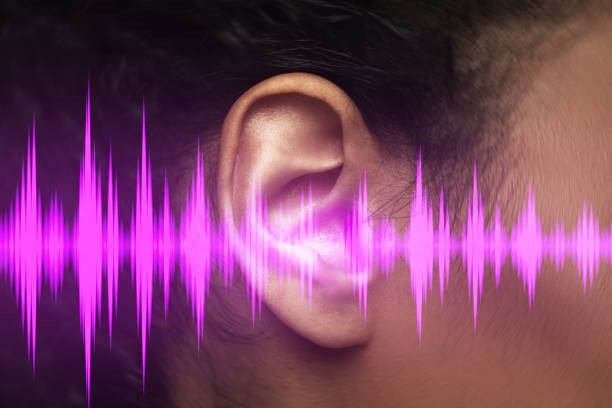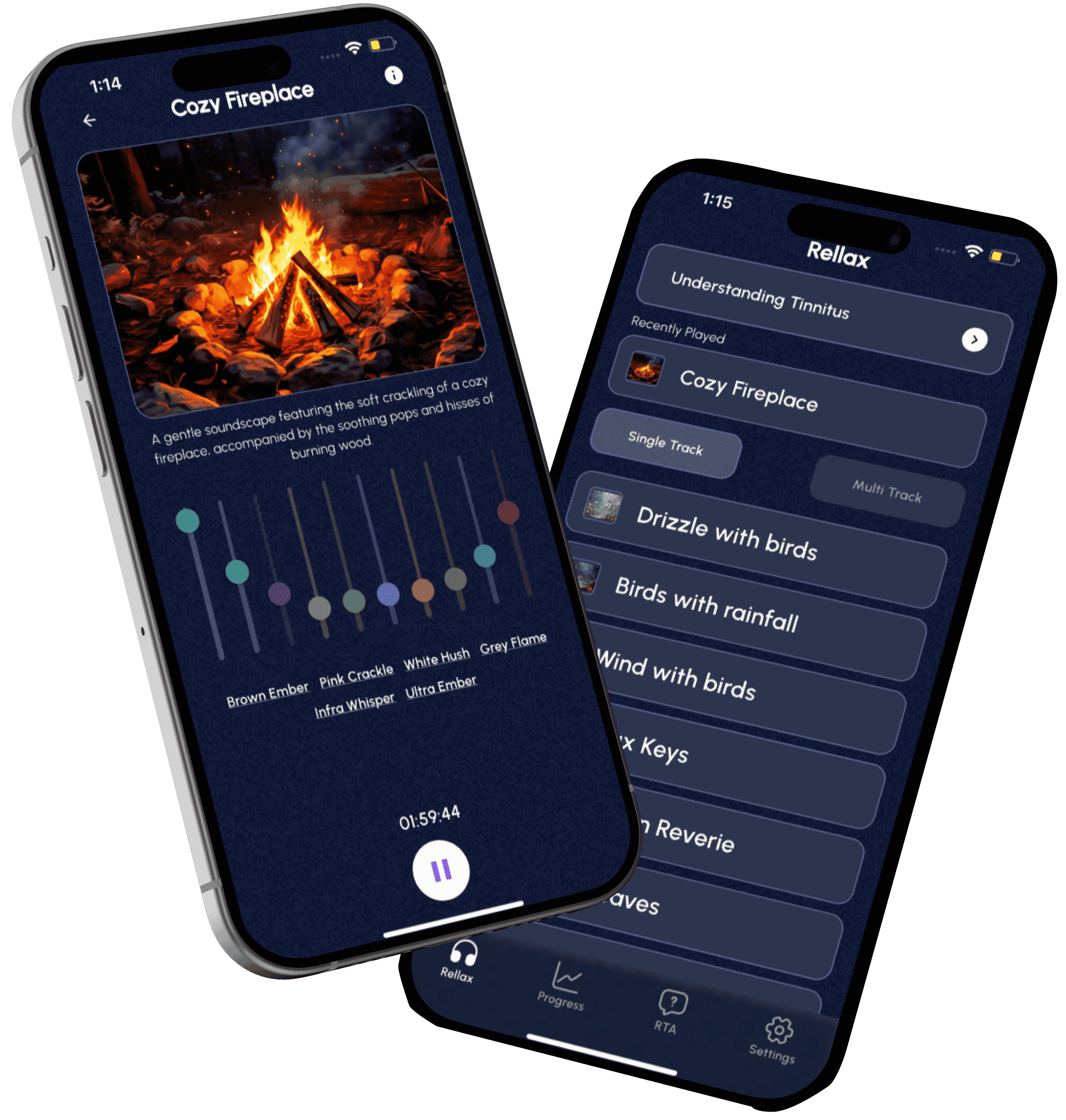
Introduction
Tinnitus is the sound of ringing, buzzing, or humming in your ears when there’s no real noise around you. For some people, it’s soft and manageable. For others, it’s loud, distracting, and hard to live with.
One of the most popular ways people try to get relief is through sound therapy. But does it actually help? Can it make the ringing go away? And how long do you have to use it before you notice a difference?
In this blog, we’ll answer all of these questions in simple, easy words. Whether you’re just starting to learn about tinnitus or you’ve had it for years, you’ll find helpful advice here and a way forward with Rellax, a sound therapy app designed specifically to help people manage their tinnitus.
What Is Sound Therapy?
Sound therapy is a way of using calm, soothing sounds to help your brain focus on something other than the ringing in your ears. These sounds could be gentle rain, ocean waves, soft wind, or low, steady tones. You can play them using a phone, headphones, a speaker by your bed, or a dedicated therapy device.
Apps like Rellax offer these sounds in a simple and safe way. The goal is to help your brain stop focusing so much on the tinnitus and start feeling more relaxed.

How Does Sound Therapy Work for Tinnitus?
Scientists believe the brain can “retrain” itself. When soothing audio fills the room, the brain gets a new, friendly sound to focus on. Over time, it learns that the ringing is not important.
Binaural tinnitus sound therapy: Two slightly different tones, one in each ear, help the brain relax even more.
Tinnitus retraining therapy sounds: Long, steady noises chosen by experts guide the brain to calmer listening habits.
How Long Does It Take for Sound Therapy to Work?
It depends, but you usually need to give it a few weeks to a few months.
Some people start to feel better within a couple of weeks. Others need more time, especially if their tinnitus is severe or if they’ve had it for a long time. What matters most is using it every day.
Most doctors recommend at least 1-2 hours of listening daily. This can include when you’re sleeping. It doesn’t have to be loud or complicated. Even quiet, steady sound playing in the background helps retrain your brain and reduce the focus on the ringing.
Does Sound Therapy Cure Tinnitus?
No, sound therapy does not cure tinnitus.
There is no known cure for tinnitus yet. But sound therapy can greatly reduce how noticeable or bothersome the ringing feels. Many people say that after using it daily, they sleep better, feel less anxious, and can ignore the sound more easily during the day.
So while it’s not a cure, it’s one of the most effective ways to manage tinnitus, especially when used consistently over time.
Does Sound Therapy Really Help?
Yes, sound therapy really does help many people with tinnitus.
Research and real-life experiences show that it can lower stress, improve sleep, and reduce the emotional impact of tinnitus. Over time, your brain starts to see the ringing as less important, and it becomes easier to ignore.
Think of it like this: if your brain is constantly hearing silence and ringing, the ringing stands out. But if you fill your space with peaceful sounds, your brain has something else to focus on and the ringing blends in more easily.
What Kind of Sounds Work Best for Tinnitus?
There’s no single sound that works for everyone. Some people like low, deep sounds like a soft hum or wind. Others prefer high-pitched tones or natural noises like rainfall or ocean waves.
One thing that can make a big difference is matching the volume of the sound to your tinnitus. That’s something Rellax is built to do, it learns about your tinnitus and offers sounds that are more likely to soothe your specific experience.
Is There a Certain Frequency That Can Cure Tinnitus?
No, there isn’t one magical frequency that cures tinnitus.
But playing sounds that match your tinnitus tone in volume, or fall close to it, can help your brain stop paying attention to the ringing. It’s about finding what feels most comfortable and using it daily.
That’s where personalized sound therapy makes a difference. Rellax is designed to help you find the right sound and use it the right way.

Has Anyone Ever Cured Tinnitus?
Rarely, but it can happen.
Some people say their tinnitus disappeared completely, especially after treating another health problem or changing their lifestyle. But for most people, it doesn’t go away, it just becomes easier to live with.
The good news is that managing it is possible. With the right tools and routine, you can feel in control again.
Can Sound Therapy Make Tinnitus Worse?
Very rarely, yes, but only if the volume is too high or the sound is harsh or annoying to you.
This is why it’s so important to use calm, steady sounds and keep the volume low. You should always be able to hear your environment along with the therapy sounds. If it feels overwhelming, turn it down or switch to a different sound.
The Rellax app offers many soothing options and lets you adjust everything to your comfort level.
Who Should Avoid Sound Therapy?
Most people can safely use sound therapy. But if you have another hearing condition, extreme sensitivity to sound, or ongoing ear pain, it’s a good idea to talk to a hearing specialist first.
Also, if you feel more anxious when using certain sounds, stop and try something gentler. Your comfort matters most.
How to Start Sound Therapy for Tinnitus?
Starting is easy. Here’s what to do:
Pick a calming sound: Something that doesn’t bother you and feels peaceful. Rellax has a library of expert-designed options.
Set the volume low: You should still hear your surroundings.
Use it every day: Especially in quiet moments or at night.
Stick with it: Don’t expect results overnight, but give it at least 4 to 6 weeks.
Track your progress: Notice if you’re sleeping better or feeling less distracted by the ringing.
Adjust as you go: Change tones or volume if needed.
That’s it. There’s no complicated setup, no extra equipment needed.
Conclusion:
Tinnitus can be frustrating, but you are not helpless. While there’s no cure, sound therapy gives you a real, proven way to take back control. It trains your brain, helps you relax, and makes the ringing feel quieter over time.
If you’re consistent and patient, the results can be life-changing.
How Rellax Can Help You
Rellax delivers the exact frequency-matched, expert-designed sound therapy YOU need to manage tinnitus.
Whether your tinnitus is new or something you’ve had for years, Rellax is ready to help you move toward relief, calmly, gently, and at your own pace.
Download Rellax today and take your first step toward quieter days and better nights.
Frequently Asked Questions (FAQs)
Not completely, but sound can make it feel much less noticeable and easier to manage.
The best therapy is one that’s personalized to your needs. Rellax offers custom-matched sounds that fit your specific tinnitus pattern.
Yes, in fact, nighttime use is one of the best times to do it. Just keep the sound low and soothing.
No. Rellax works from your phone and can be used with regular earphones or speakers.
Have any question?
Do not hesitate to contact us. We’re a team of experts ready to talk to you.
ryan@rellax.co
5 Data-Backed Strategies to Improve Patient Outcomes for Tinnitus Management
Introduction
Tinnitus is one of the most cumbersome challenges in audiology. No two patients present the same symptoms, and treatment outcomes can vary dramatically, even when using the same approach. The unpredictable nature of tinnitus, combined with the emotional toll it takes on patients, often leaves audiologists searching for better, more consistent strategies.
As expectations for personalized care grow, audiologists are now turning to tools and techniques grounded in data, ongoing tracking, and tailored therapy. The days of one-size-fits-all are over.
In this blog, we’ll walk through five data-backed strategies that can help you improve tinnitus therapy, increase patient engagement, and ultimately deliver better tinnitus treatment outcomes, all while streamlining your clinical workflow.
Let’s dive in.

1. Use Standardized Tinnitus Assessment Tools
Before diving into treatment, it’s crucial to understand the full scope of your patient’s symptoms. Tinnitus presents differently for everyone. Some patients hear a faint hum, while others experience a loud, distressing ring.
Standardized tinnitus assessment tools help you gather clear, measurable information about how tinnitus impacts your patient’s daily life. This makes it easier to create a treatment plan tailored to their unique experience.
What the Data Says:
A 2024 study published in The Journal of Audiology found that clinics using standardized assessment tools like the Tinnitus Handicap Inventory (THI) were able to adjust treatments more effectively, resulting in a 28% improvement in patient-reported outcomes within the first three months of therapy. By leveraging these tools to monitor symptom changes, audiologists were able to identify effective interventions more quickly and minimize trial-and-error in treatment approaches.
Common Tools Used in Tinnitus Assessment:
Tinnitus Handicap Inventory (THI):
A 25-question survey measuring emotional, functional, and catastrophic responses to tinnitus.
Tinnitus Functional Index (TFI):
Assesses the impact of tinnitus on various aspects, including sleep, concentration, and emotional well-being.
Visual Analog Scales (VAS):
Simple 0–10 scales measuring the perceived loudness, annoyance, or distress caused by tinnitus.
Tinnitus Reaction Questionnaire (TRQ):
A 26-item questionnaire that evaluates the emotional distress associated with tinnitus, including anxiety, depression, and irritability. It helps audiologists understand how tinnitus is affecting a patient’s mental health and quality of life.
Why These Tools Matter:
By using standardized assessment tools, you can objectively measure the impact of tinnitus, track symptom progression, and adjust interventions accordingly. This structured approach ensures that treatment plans are personalized and responsive to your patient’s specific experience.
2. Match the Sound to the Symptom: How Personalized Therapy Helps
Every tinnitus patient is unique. The intensity and frequency of the ringing sound they hear can vary from person to person, making it essential to provide personalized sound therapy that addresses each patient’s specific symptoms.
What the Data Says:
A meta-analysis conducted by JAMA Otolaryngology in 2020 found that personalized sound therapy was significantly more effective than generic sound therapy in reducing tinnitus intensity. Patients who received sound therapy tailored to their specific frequency and pitch of tinnitus experienced a 40% reduction in perceived tinnitus severity.
How to Implement Personalized Sound Therapy:
Symptom Matching Algorithms:
Tools like Rellax use symptom profiling algorithms to create personalized sound therapy based on the patient’s tinnitus characteristics. This can include matching sound frequencies, volume, and tone to the patient’s specific tinnitus pattern, enhancing the effectiveness of the therapy.
Find the Blend Point:
One important technique is identifying the blend point, the frequency and volume where the therapeutic sound merges with the patient’s tinnitus sound. At this point, the brain begins to filter out the tinnitus more easily, reducing its perceived intensity. Using the blend point helps patients achieve quicker relief and greater comfort during therapy.
Adaptive Sound Libraries:
Sound therapy can include a wide range of audio options, such as nature sounds, white noise, or calming music. However, many modern tinnitus management tools now follow the principles of Tinnitus Retraining Therapy (TRT), which emphasizes the use of broadband noise. This type of sound is designed to blend with the tinnitus signal and help the brain gradually tune it out. Platforms like Rellax are built around this concept, offering customizable broadband sound options that support consistent and comfortable therapy. By adapting the sound stimuli to each patient’s tinnitus profile and comfort level, therapy becomes more effective and easier to stick with.
Why It Works:
Personalized sound therapy helps patients focus on specific frequencies that are tolerable to the patient, reducing the perceived intensity of the sound. When patients use tailored therapies, they’re more likely to adhere to treatment and experience better long-term results.

3. Address the Mind: Combining CBT with Sound Therapy
It’s not just about treating the ears; it’s also about treating the mind. Many patients with tinnitus experience anxiety, depression, and distress, which can worsen their symptoms. Combining sound therapy with cognitive behavioral therapy (CBT) is a highly effective way to address both the physical and psychological aspects of tinnitus.
What the Data Says:
A study published in The Lancet showed that patients who underwent both CBT and sound therapy experienced a 50% reduction in tinnitus-related distress within six months. CBT helps patients reframe negative thoughts, reducing the emotional burden of the condition.
How to Implement CBT:
Partner with Mental Health Professionals:
Collaborating with licensed mental health professionals can help you offer CBT in conjunction with sound therapy.
Offer CBT Modules through Tinnitus Apps:
Many tinnitus management platforms now offer guided CBT sessions as part of their treatment plans, which patients can access remotely.
Why It Works:
CBT helps patients change the way they perceive their tinnitus, making it less distressing. When combined with sound therapy, CBT provides a comprehensive approach that treats both the physical and emotional aspects of tinnitus.
4. Keep Patients on Track: Why Consistency Makes All the Difference
Consistency is key when it comes to managing tinnitus. Many tinnitus therapies, including sound therapy and cognitive behavioral therapy (CBT), require patients to stay engaged in their treatment. Ensuring therapy adherence can significantly improve treatment outcomes.
What the Data Says:
A study published in The Journal of the American Academy of Audiology found that clinics using digital tracking tools saw a 25% increase in therapy adherence and a 35% decrease in patient dropout rates. When patients feel supported and engaged, they’re more likely to stick to their treatment plan.
How to Monitor Patient Engagement:
Patient Management Dashboards:
Tools like Rellax’s patient dashboard allow audiologists to monitor patient progress in real time. These platforms can track patient engagement, session completion, and symptom changes, providing audiologists with valuable insights into how well patients are adhering to their treatment plans.
Automated Reminders:
Apps or email reminders encourage patients to stay on track, reinforcing the importance of consistent treatment.
Why It Works:
Better engagement leads to better outcomes. When patients are actively involved in their tinnitus management, they’re more likely to experience positive results. Digital tools help make engagement seamless, improving the overall treatment process.
5. Use Outcome Data to Continuously Optimize Therapy
The best way to improve tinnitus therapy is by making data-driven decisions. Continuously tracking patient progress and using outcome data to refine treatment plans helps audiologists deliver more effective and personalized care.
What the Data Says:
A 2024 study published in the Journal of Otolaryngology used high-frequency audiometry data with machine learning models and achieved over 94% accuracy in diagnosing tinnitus. This proves that data isn’t just useful, it’s essential for improving diagnosis and ongoing care.
Moreover, industry reports highlight that audiology practices using digital dashboards and trend analysis tools are reducing dropout rates and increasing therapy adherence by 30–40%.
How to Use Outcome Data:
Track Progress with Patient Feedback:
Collect patient feedback regularly, either digitally or in person, to assess progress and identify areas for improvement.
Use Trend Analysis to Adapt Therapy:
Analyzing trends in patient data helps identify patterns. If a patient’s tinnitus intensity worsens, therapy can be modified promptly.
Why It Works:
Real-time data allows audiologists to adapt treatment quickly. By continuously optimizing therapy, audiologists can ensure that patients receive the best possible care throughout their treatment journey.

Conclusion
Improving patient outcomes for tinnitus management requires a combination of personalization, consistent tracking, and evidence-based interventions. By integrating standardized tinnitus assessment tools, personalized sound therapy, and mental health support like CBT, audiologists can offer more comprehensive and effective treatment. Additionally, using outcome data to continuously refine therapy plans ensures that patients receive the best possible care.
If you’re looking for a tool that can help streamline tinnitus management, improve patient engagement, and enhance treatment outcomes, Rellax offers a comprehensive, evidence-based solution. By incorporating personalized sound therapy and real-time patient monitoring, Rellax empowers audiologists to provide better care and achieve better results for their tinnitus patients.
Join the Rellax Partner Program Today!
Frequently Asked Questions (FAQs)
1. What is the most effective treatment for tinnitus in 2025?
The most effective treatment depends on the individual, but combining sound therapy with behavioral interventions like CBT, while continuously tracking patient progress, leads to better outcomes.
2. How can I improve my patients’ tinnitus therapy outcomes?
Use standardized assessment tools, track therapy adherence, apply outcome data regularly, and integrate CBT techniques alongside sound therapy for comprehensive support.
3. Is there a data-driven way to manage tinnitus more effectively?
Absolutely. Audiologists using digital platforms and analytics tools have reported up to a 45% improvement in tinnitus treatment outcomes by adapting therapy based on real-time data.



